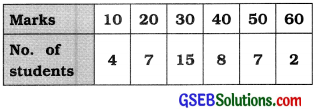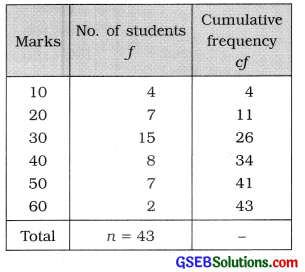Gujarat Board Statistics Class 11 GSEB Solutions Chapter 4 Measures of Dispersion Ex 4.2 Textbook Exercise Questions and Answers.
Gujarat Board Textbook Solutions Class 11 Statistics Chapter 4 Measures of Dispersion Ex 4.2
Question 1.
A shooter missed his target in the last 10 trials by the following distance (mm) during the practice session:
20, 32, 24, 41, 18, 27, 15, 36, 35, 25
Find the quartile deviation and coefficient of quartile deviation of such distance missed by the shooter.
Answer:
Writing the measures of mistargets in ascending order :
15, 18, 20, 24, 25, 27, 32, 35, 36, 41
Here, n = 10
First Quartile :
Q1 = Value of \(\left(\frac{n+1}{4}\right)\)th observation
= Value of \(\left(\frac{10+1}{4}\right)\) = 2.75 th observation
= Value of 2nd observation +0.75 (Value of 3rd observation – Value of 2nd observation)
= 18 + 0.75 (20 – 18)
= 18 + 0.75 (2)
= 18 + 1.50 = 19.50 mm
Third Quartile :
Q3 = Value of 3\([latex]\left(\frac{n+1}{4}\right)\)[/latex] th observation
= Value of 3 (2.75) = 8.25th observation
= Value of 8th observation + 0.25 (Value of 9th observation – Value of 8th observation)
= 35 + 0.25 (36-35)
= 35 + 0.25 = 35.25 mm
Quartile deviation of measures of mistargets :
Qd = \(\frac{\mathrm{Q}_{3}-\mathrm{Q}_{1}}{2}\)
Putting Q3 = 35.25; Q1 = 19.50, we get
Qd = \(\frac{35.25-19.50}{2}=\frac{15.75}{2}\) = 7.875 ≈ 7.88
Coefficient of quartile deviation = \(\frac{\mathrm{Q}_{3}-\mathrm{Q}_{1}}{\mathrm{Q}_{3}+\mathrm{Q}_{1}}\)
= \(\frac{35.25-19.50}{35.25+19.50}\)
= \(\frac{15.75}{54.75}\)
= 0.29
![]()
Question 2.
Find the quartile deviation and coefficient of quartile deviation of the marks from the following frequency distribution of marks of 43 students of a school;

Answer:

First Quartile :
Q1 = Value of \(\left(\frac{n+1}{4}\right)\)th observation
= Value of \(\left(\frac{43+1}{4}\right)=\frac{44}{4}\) = 11th observation
Referring to column cf,
Q1 = 20 marks
Third Quartile :
Q3 = Value of \(\left(\frac{n+1}{4}\right)\)th observation
= Value of 3(11)
= 33 rd observation Referring to column cf,
Q3 = 40 marks
Quartile deviation of marks:

![]()
Question 3.
The distribution of amount paid by 200 customers coming for snacks at a restaurant on a particular day is given below:

Find the quartile deviation and coefficient of quartile deviation of the amount paid by customers on the day.
Answer:
| Amount paid ₹ | No. of customers f | Cumulative frequency cf |
| 0-50 | 25 | 25 |
| 50- 100 | 40 | 65 |
| 100-150 | 80 | 145 |
| 150-200 | 30 | 175 |
| 200 – 250 | 25 | 200 |
| Total | n = 200 | – |
First Quartile:
Q1 Class = Class that Includes \(\left(\frac{n}{4}\right)\)th observation
= Class that includes \(\left(\frac{200}{4}\right)\) = 50th observation
Referring to column cf
Q1 class = 50 – 100
Now, Q1 = L + \(\frac{\left(\frac{n}{4}\right)-c f}{f}\) × c
Putting L = 50: \(\left(\frac{n}{4}\right)\) = 50: cf = 25: f = 40 and c = 50 In the formula,

Third Quartile:
Q3 Class = Class that Includes 3\(\left(\frac{n}{4}\right)\)th observation
= Class that Includes 3 (50)th = 150th observation
Referring to column cf. Q3 class = 150 – 200
Now. Q3 = L + \(\frac{3\left(\frac{n}{4}\right)-c f}{f}\) × c
Putting L = 150: 3\(\left(\frac{n}{4}\right)\) = 150: cf = 145; f = 30 and c = 50 in the formula.
